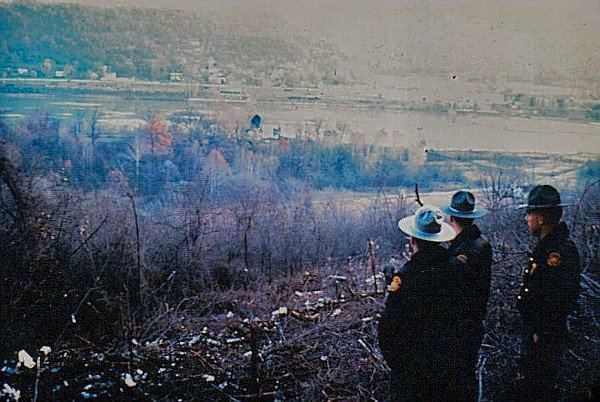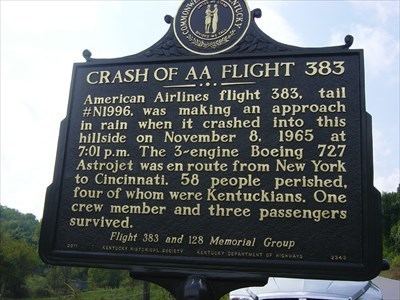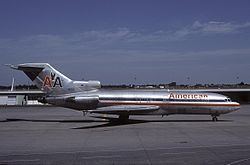Crew 5 Injuries (nonfatal) 4 | Passengers 57 Fatalities 58 Number of deaths 58 | |
 | ||
Survivors 4 (3 passengers and 1 crew member) Date November 8, 1965, 1:38 PM GMT-8 Destinations Similar TWA Flight 128, United Airlines Flight 389, United Airlines Flight 227, Eastern Air Lines Flight 663, LAN Chile Flight 107 | ||
American Airlines Flight 383 was a nonstop flight from New York City to Cincinnati on November 8, 1965. The aircraft was a Boeing 727, with 57 passengers, and 5 crew on board. The aircraft crashed on approach to the Cincinnati/Northern Kentucky International Airport. Only three passengers and one flight attendant survived the crash.
Contents

Aircraft

The aircraft involved was a Boeing 727-100 (registration number N1996), serial number 18901. The Boeing 727 was delivered to American Airlines on June 29, 1965, and had operated a total of 938 hours at the time of the accident.
Events leading to the crash

The flight was delayed for 20 minutes in New York. Until the landing attempt, the flight from New York to Cincinnati was uneventful. At 18:45 Eastern Standard Time, the crew contacted the airline via ARINC company radio to report a 19:05 estimated time of arrival at Cincinnati. The weather was fine near the airport except for thunder clouds developing northwest of the airport across the Ohio River valley. At 18:57, Flight 383 was cleared by the approach controller for a visual approach to Cincinnati's runway 18, and was advised of precipitation just west of the airport. The aircraft approached the airport from the southeast and turned its heading to north to cross the Ohio River. It turned west after crossing to the northern shore of the Ohio River, intending to make a final turn to southeast after crossing the Ohio River (which runs from northwest to southeast) again to the southern shore of the river. After that final turn, the aircraft would line up with the runway 18 of the airport to make the final approach.

At 18:58, the approach controller transferred Flight 383 to the Cincinnati tower frequency. At 18:59, Flight 383 received clearance from the tower controller to land on runway 18.
Crash

The aircraft flew into thick cloud and thunderstorm after flying into the northwest of the airport. It descended more rapidly than it should have, without either pilot in the cockpit noticing. The airport is situated at an altitude of 853 feet (260 m) and the aircraft had descended to the level of 553 ft (169 m) above the airport while it was still about 5 mi (8.0 km) northeast of the airport. It descended to just 3 ft (per altimeter) above the airport while it was about 3 nm north of the airport. Its correct altitude should have been just below 1,000 ft (300 m) at that time. It continued its descent into the Ohio River valley while crossing the river back to the southern shore. When it made its last turn to the southeast to line up with the runway, it flew into the wooded slopes of the valley 3 km north of the runway threshold in poor visibility, at an altitude of -225 ft (i.e. 225 ft (69 m) below the runway's altitude). It then exploded and was engulfed in flames.

Of the 62 people on board the aircraft, only four people (one flight attendant and three passengers) survived. One of the survivors was Israel Horowitz, an American record producer.
Investigation
The Civil Aeronautics Board (CAB) investigated the accident. CAB investigators concluded that the aircraft was working normally and fully under the control of the pilots at the time of the crash. The aircraft was not equipped with a cockpit voice recorder. The flight data recorder showed the aircraft descended through 500 feet (150 m) in the last 42 seconds before impact, a normal rate of descent for the landing phase of operation. The CAB determined that the probable cause of the accident was the pilots' failure to properly monitor their altitude during a visual approach into deteriorating weather conditions.
It was later believed that the following factors might have contributed to the crash:
Aftermath
The estate of Samuel Creasy, one of the passengers who died aboard Flight 383, sued American Airlines for wrongful death. American Airlines responded by filing a third-party complaint against the Federal Aviation Administration and the Weather Bureau, in an attempt to shift liability for the crash to meteorologists and air traffic controllers for failure to warn the pilots of inclement weather or revoke the visual approach clearance. American Airlines also alleged that the accident was due to a downdraft rather than pilot error. A jury found American liable for the accident and awarded Creasy's family $175,000 plus funeral expenses, a decision that was upheld on appeal to the Fifth Circuit Court of Appeals.
Two years after the crash of Flight 383, TWA Flight 128 crashed on the same hill while on approach to Cincinnati under poor visibility conditions.
